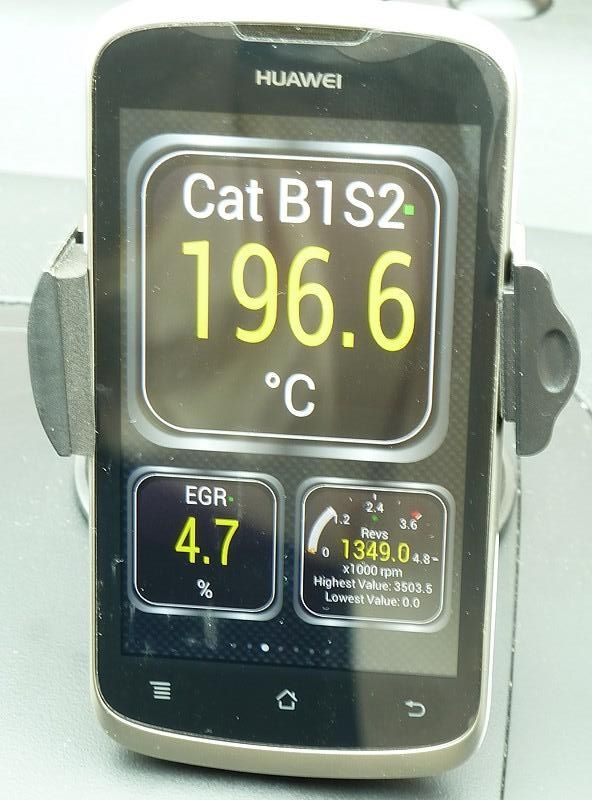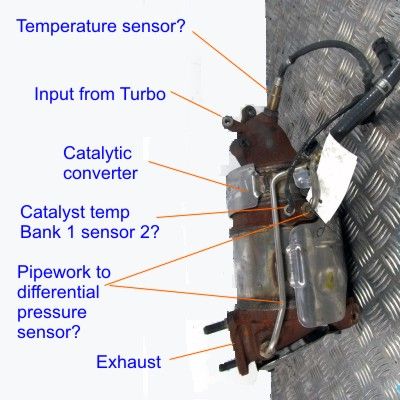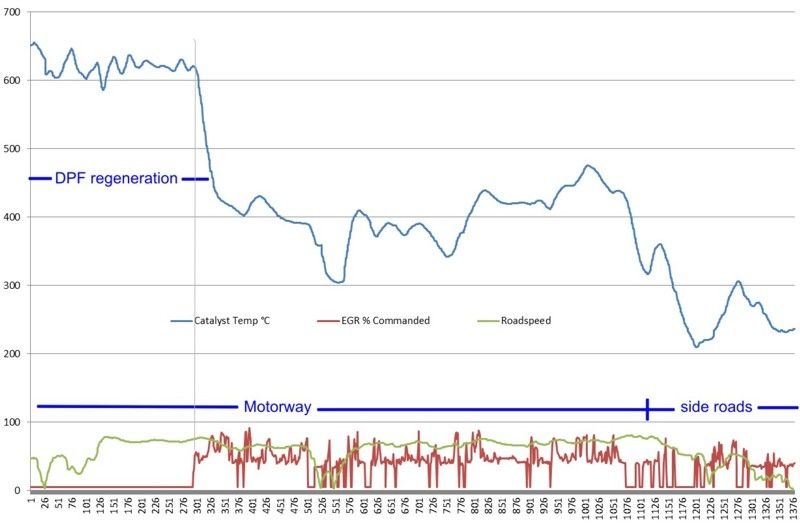OK so having had some success with tracking down regeneration using OBDII, I thought I would try to summarise some of what we've all learnt. My thanks to the other contributors whose stuff I have incorporated (and hopefully acknowledged)
DPFs: what do we know?The Kia/Hyundai 1.6L diesel uses a Catalysed Particulate Filter (CPF) i.e. a catalytic converter bolted to the output of the turbo at the back of the engine, with a Particulate Filter in the bottom 2/3rds of the CPF canister, as shown below.

[source:
http://www.engine-expo.com/forum_2009/pdfs/day2/5_sunghwan_cho.pdf slide 25]
So if you were going to remove the CPF, you would have to remove the whole shebang and replace it with just a catalytic converter. This is precisely what some performance aftermarket exhausts do. You would also have to remap the engine so it didn’t try to regen a non-existent CPF.
Close-coupled DPFs don’t use magic liquid, just heat to remove soot.
Passive regeneration takes place above 2250 RPM, minimising soot build-up. My observations of the Catalyst temperature reading available over the OBD suggests that you need to be travelling at 60 MPH in 6th to reach 400°C, and over 70 MPH to reach 500°C.
An active regen cycle takes about 20 minutes and involves extra injections per power stroke:
• A pre-injection to quieten it down;
• Then the main quantity and
• two post-burn doses which get flushed out into the DPF.
When a DPF regen cycle is going, the turbo vanes are wide open and the EGR valve is shut, so no EGR is happening.
During a regen cycle we can expect OBDII monitoring to show:
• Catalyst Temperature – significantly higher than normal
• Exhaust Gas Recirculation (EGR) – should be at minimum value (4.71%) = OFF
The Catalyst Temperature is reported on OBDII as “Catalyst Temperature Bank 1 Sensor 2”, and has been observed to range from 110°C to 540°C in normal, spirited driving.
This is monitored whilst driving using Torque Pro running on an Android smartphone whichg is being fed with OBDII data from a VGate Bluetooth dongle (£25 on eBay). When the Cat B1 S2 value gets to more than 575°C, you’re in regen territory.

This image below is from an eBay advert for an i30 CPF and shows the whole thing (it’s about the size of a Rugby ball).
It seems plausible that the pipework feeds two sides of a differential pressure sensor which can trigger a regen cycle. However the evidence from members suggests that regens triggered by distance are more common.
My OBDII temperatures come from one of the two sensors shown - probably the one between the catalytic converter at the top and the DPF at the bottom of the canister.
 How frequently does it need a regen?
How frequently does it need a regen?My guess is that the same CPF is used on all three flavours of the 1.6 Kia/Hyundai diesel (90, 115 and 128 HP versions). It would be logical if the higher-powered versions filled their DPF canisters more quickly than the less powerful engines, and hence regen more often.
So from the Hyundai and Kia forums we get:
AlanHo 128 HP Hyundai Regen every 260 miles
SportWagon 115 HP Kia Regen every 300 miles
neoto 90 HP Hyundai Regen every 435 miles
So is the Hyundai CPF simply too small to hold a sensible amount of soot before it needs to regen?
How hot does it need to be?“Catalyzed Diesel Particulate Filters (CDPF) are designed not only to achieve collection efficiencies of 90% or greater in terms of mass (over 95% when expressed as number of ultra fine particles), but also to burn off the collected particulate matter into carbon dioxide and water…The incorporation of a catalytic coating in CDPFs lowers the temperature at which particulate matter burns. To achieve this auto-ignite and the sustained combustion of collected particulate matter CDPFs must attain a minimum temperature of approximately 250°C”.
[source:
http://www.tdciforum.co.uk, quoted in
http://www.honestjohn.co.uk/faq/diesel-particulate-filters/, 19/7/13]
“Only a portion of the particulates are converted to carbon dioxide during passive regeneration and due to chemical reaction this process is only effective within the temperature range of 250°C to 500°C. Above this temperature range the conversion efficiency of the particulates into carbon dioxide subsides as the temperature of the filter increases.
Active regeneration takes approximately 20 minutes to complete. The first phase is to raise the temperature of the filter to particulate combustion temperature of 500°C.
In the second phase the temperature is raised to 600°C, the optimum particulate combustion temperature. This temperature is maintained for 15 to 20 minutes to ensure complete incineration of the particulates captured in the filter. The incinerated particulates produce carbon dioxide and water.”
“Temperature before the turbocharger inlet must remain below 830°C for turbocharger protection.
Close-coupled catalyst in-brick temperatures must not exceed 800°C and exit temperature must remain below 750°C”
[source: “DPF Use and Regeneration – For Technophiles” by AlanHo
https://www.i30ownersclub.com/forum/index.php?topic=13595.msg149163#msg149163 ]
Rules of thumb“Needs to run at > 2,250 RPM for > 45 minutes every month.”
“During the regeneration, the fuel consumption is higher for about 2-3l/100km”
[source: neoto reply #1 in
https://www.i30ownersclub.com/forum/index.php?topic=13595.msg149163#msg149163 ]
If the car needs an ACEA C3 oil, it’s got a CPF. [source: i30 owner’s manual]
Using diagnosticsYou
can use OBDII diagnostics to show when a regen cycle is happening. I didn’t manage to log the start of a cycle, but the end is flagged by EGR turning back on from the fully-off state during the regen cycle, and the Catalyst temperature drops by about 200 °C:

I'm happy to be corrected on any of this, but it makes sense to me. I'll try to catch the start of the next regen cycle on my car and see what is triggering it. The attached document describes the PIDs which I can log with my OBDII setup (on a 2011 FD i30 Comfort).
